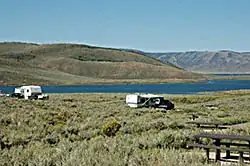Several different ideas occur to me:
Badlands, are areas where rain is actually the enemy of fertility and life. When you have deep underlying sediment that is poorly consolidated and at a reasonable altitude above the local Base Level deep and rapid erosion precludes soil formation and retention.
Wind, wind driven sand can easily account for those areas of the coastline near desert edges that would otherwise be fertile where they are down wind of the major sand and dust deposits. Winds can also rob an area of fine material as in the formation of Desert Pavement, preventing soil development.
Volcanic activity can create several different kinds of wasteland:
- fresh deposits, freshly cooled lava is extremely barren and depending on it's chemistry and the local climate weathering can be extremely slow. Equally fresh ash falls are also extremely inhospitable and can continue to be for extended periods even in geological terms.
- rocky deposits like those left by ʻAʻā lava flows are even slower to accumulate sufficient erosive and organic material for soil formation due to the deep "boulder field" terrain they leave on the surface.
- nutrient poor magma, if the chemistry of the erupted material is deficient in certain elements then any soil that does form can't support flora and fauna, in New Zealand Cobalt Poor Soils on old Ignimbrites from Rhyolite eruptions causes "bush sickness" in stock.
- chemically difficult material, Ultramafic Lavas, some Andesite eruptions, and some forms of Carbonatites are so rich in certainly elements, like Magnesium or Florine, that they're antagonistic to life trying to colonise their deposits. This is an effect that can spread over huge areas in the case of Florine in ash from explosive eruptions.
- Sulfur, forms a number of toxic and/or corrosive compounds that often leach from volcanic deposits and can kill plants and animals directly or indirectly because it liberates toxic but normally stable compounds from the soil around them.
- Carbon Dioxide, a build up of CO2 in the soil as it percolates up from volcanic deposits underground suffocates plant roots and can even displace oxygen close to the ground killing wildlife directly.
- heat, just having geothermal fluid, whether in the form of magma or super-heated water, close to the surface can kill plant roots and restrict the growth of plants that have shallow enough root systems to survive anyway.
Salt, deposits of salt, whether waterborne or geological in origin, are lethal to a good number of plants and limit animal life in the area accordingly. This can be an ongoing problem down stream of such deposits as the rainwater that falls on such areas is too saline to support life. Such deposits are not limited to Sodium Chloride table salt either, they can include any water soluble metal salts that are toxic in high doses.
Plant life, if your aim is to make an area impassible by reason of lack of forage then it can be relatively lush; if the plants are toxic, Oleander, Caster, and many Nightshades are toxic in part or as a whole. In areas where rainfall is scarce but reasonably reliable specially adapted plants are the norm so you could use large bands of "poison forest" to make areas impractical to navigate. For that matter forests dominated by coniferous species aren't friendly to beasts of burden or to humans trying to live off the land.
Karst, landscapes can be extremely dangerous to travelers who are unfamiliar with the area and tend toward surface aridity even when local rainfall is extremely high.
Wetlands, if direct drainage routes are blocked, in part or wholesale, then water accumulates drowning most plants out and creating unstable bogs, trackless marshy glasslands, swamps with open water amid maze like forest or fens where the flow of water pulls you off-track over even short distances.
That's everything I can think of off the top of my head.
